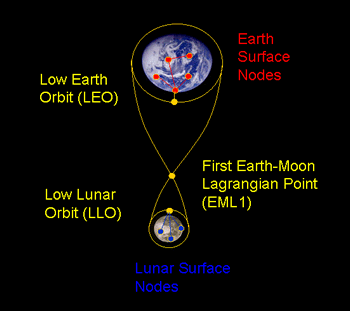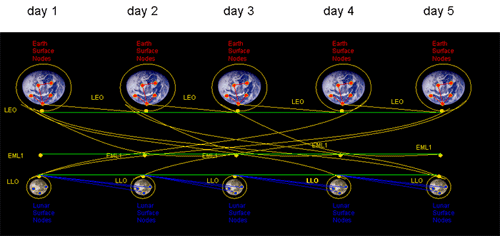Space Network Modeling
The space network provides the basic building block for all logistical decisions. It defines the entire set of allowable transfers to and from all points of interest. Networks are traditionally used in terrestrial transportation systems to represent physical locations and the connections between them. For space transportation networks, the concept of a location is abstracted to represent points of interest, such as orbits or Lagrange points. In addition, space networks have an additional burden of time varying properties.
In space logistics, two types of networks are considered. The first one, termed the static network, captures the possible trajectories between locations regardless of the time. The time expanded network then builds on top of the static network by embedding time dependent aspects.
Static Network
The physical network, or static network, represents the set of physical locations – nodes – and the connections – arcs – between them. The static nodes represent various physical locations in space. Three types of nodes have been identified:
- Body nodes—such as Earth or the Moon surface locations
- Orbit nodes—such as Low Earth Orbit (LEO) or Low Lunar Orbit (LLO)
- Lagrange point nodes—such as Earth-Moon Lagrange point 1 (EML1)
The arcs represent the physical connections between two nodes, that is, the family of trajectories that can be traversed between two physical locations.

Figure 1 depicts an example of an Earth-Moon transportation network. The network consists of five Earth surface nodes and three lunar surface nodes, along with orbital nodes at low Earth orbit (LEO) and low lunar orbit (LLO), and a node at the Earth-Moon Lagrangian Point (EML1). The connections between the nodes represent the trajectories available to travel through the network. For each of the arcs there is an associated range of travel times available based on different transfer orbits. For example, the transfer from LEO to EML1 can take between 3 and 3.7 days.
Time Expanded Network
The space logistics project is investigating the design of a sequence of missions that evolve over an extended period of time. In addition, certain properties of the space network are time-varying. For these reasons we introduce a time expanded network. In the time expanded network, the absolute time interval under consideration is discretized, and a copy of each static node is made for each of the time points. The nodes are connected according to the following rules:
- The arc must exist in the static network.
- The arc must create a connection that moves forward in time.
- The arc must represent a feasible transfer, in terms of orbital dynamics.

Figure 2 depicts the time expanded network corresponding to the static network in Figure 1. Here, the overall time horizon in this example is 5 days and time is discretized by the day. In addition, all travel times are rounded up to the next day. For example, since it takes between 3 and 3.7 days to travel from LEO to EML1, in the time expanded network, these transfers are represented by two arcs: from LEO at day 1 to EML1 at day 4, and from LEO at day 1 to EML1 at day 5. In addition, the time expanded network representation explicitly depicts the ability to wait at a location for a period of time, shown in Figure 2 as horizontal green lines. It is important to note that Figure 2 does not display every connection in the time expanded network (the picture would become overwhelmed with connections, obscuring the relevant information).
By representing the space network in this time expanded form, the network definition is decoupled from the celestial mechanics that govern space travel, since the existence of the arc in the time expanded network assures that a feasible transfer between two nodes exists. In addition, the time expanded network allows for a series of decisions about space logistics to be made in a holistic framework. Trade studies, such as where to create a depot, when to use the EML1 point as an intermediate transfer node, and how to utilize the moon as a staging point for Mars exploration are a natural consequence of the decision framework of the time expanded network.
